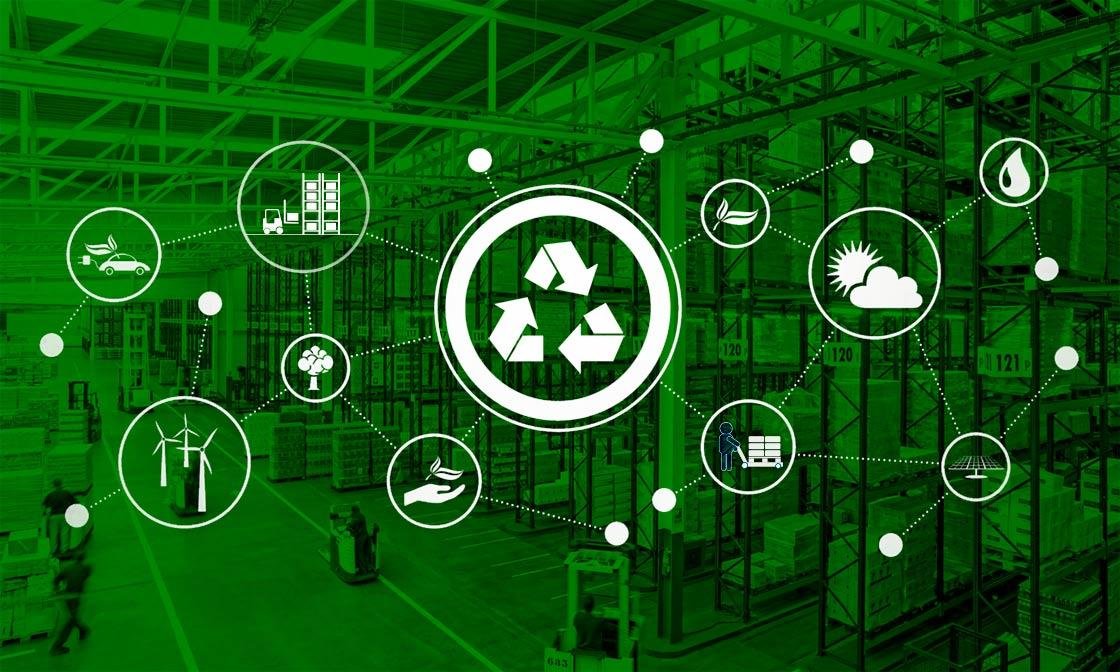Green Logistics: Examples and Benefits of Sustainable Supply Chain Practices
The world is facing tremendous environmental challenges. Global climate change, biodiversity loss, water scarcity, and massive pollution are just a few concerns today. Not to mention current wars and military conflicts, which severely impact nature. Leading businesses are doing their best to protect the environment and save our planet.
The global supply chain is experiencing radical changes as well. Companies are introducing eco-friendly practices worldwide. They cooperate with the leading IT providers engaged in logistics software solutions development to build robust innovative products that will help us make a step toward a sustainable future.
To talk about these issues, let’s discover the meaning of green logistics first. This will help us define its key processes and understand what advantages it offers to businesses and end-users.
What is green logistics?
Green or sustainable logistics is a practice of implementing an environmentally friendly approach in all the stages of the global supply chain. Manufacturing, storage, transportation, distribution, disposal, and recycling – everything is going green. This is vital at a time when the world’s population is growing rapidly. We need to conserve as many resources as possible for future generations.
Agencies, warehousing and distribution centers, freight forwarders, carriers, and others are trying to implement sustainable practices across the globe. As a result, there emerges the next-generation supply chain. In 2019, its global market was roughly assessed at $32 billion. Statista’s experts predict that this market will grow to more than twice its current size by the year 2030.
Digital transformation and environmental consciousness are major prerequisites for this meaningful change.

Examples of green logistics
Green logistics is a vast area that includes many practices and keeps on evolving. It emerged as a result of global concern about the state of the planet Earth and its resources. Once, inventors and scientists were moving technical progress forward without much thinking about what was next. Their principal aim was to facilitate the lives of people and introduce striking inventions. But with time, it became obvious that by pushing technologies and machines forward, we are endangering humankind and nature.
Businesses started to invent new efficient ways of carrying out processes. Customers saw the drastic effect of technological advances and climate change and reconsidered their attitude to consumption, too. Now, more and more people cherish eco-friendly approaches to business development, including those in the supply chain.
The most important examples of green logistics are:
Reducing carbon emissions
This is a good example of sustainable logistics and one of the first that come to mind when talking about the entire trend. To cut air pollution, companies should elaborate eco-friendly transportation methods and introduce low-emission, electric or hybrid vehicles. Furthermore, they can invest in vehicle optimization.
Another way of achieving this aim is building more efficient routes that would save time and reduce fuel consumption. Operators must analyze the existing delivery routes and think out more reasonable strategies. For instance, they can minimize the number of stops on the way to the destination or introduce changes to the order of deliveries.
Searching for alternative sources of fuel
To save fossil fuels and minimize dependency on them, one may opt for biofuels or other affordable alternatives, such as electric batteries. However, one shouldn’t blindly change one type of fuel for another. The alternatives might also affect the environment. For example, some biofuels need extensive water resources to be produced. The manufacturing of electric batteries has its downside too. So, companies should explore these options before adopting them.
Using sustainable packaging
Sustainable packaging helps to reduce waste. Retailers, cafes, and stores are widely adopting reusable or biodegradable packaging. Transportation companies and shippers also implement this practice. They use smaller packages or introduce sensible designs to reduce the amount of materials used and subsequent waste. Shipping boxes and envelopes made of recycled or compostable materials are environmentally friendly.
In addition to reducing waste, eco-friendly packaging can positively impact a company’s brand image. Consumers are increasingly interested in buying products from businesses that prioritize sustainability and environmental responsibility.
In some countries, such packaging is no longer an option but a rule. The EU has set a target of achieving 100% recyclable packaging produced within its territory by 2030.

Propelling eco-friendly materials among manufacturers
A reasonable approach to production is also one of the green logistics examples as manufacturers closely cooperate with shippers and other participants in the supply chain. Producing goods with sustainability in mind and using biodegradable or recyclable materials are important steps that businesses can take toward reducing their environmental impact. Using aluminum, glass, and certain plastics helps to minimize waste. Biodegradable materials decompose naturally, so there will be less waste in landfills.
Implementing energy-efficient technologies
Embracing energy-efficient technologies is another meaningful example of sustainable logistics. Power facilities are a critical component of the global supply chain. However, conventional methods of generating electricity, such as burning fossil fuels, harm the environment.
Companies seeking a solution to this problem should use renewable energy sources, including solar and wind power. They should invest in renewable energy infrastructure. Clean energy is becoming more affordable, so businesses can seamlessly transition to it.
Distribution centers and warehouses can buy and install robust HVAC systems. They are designed to minimize energy consumption while maintaining optimal temperatures for products and staff. Investing in energy-efficient lighting and equipment thus helps to save resources.

Controlling environmental metrics
Effective management includes a wide range of activities, including transportation, warehousing, inventory management, and order fulfillment. Businesses strive to streamline these operations. This requires constant monitoring, 24/7 access to real-time data, and in-depth analytics.
One can control the performance, analyze the state of affairs, and identify potential risks by collecting relevant data from IoT sensors and devices installed in warehouses, vehicles, shipping containers, and equipment. This will help to detect critical changes and make the necessary improvements.
For instance, if a shipment is delayed or rerouted, IoT sensors can provide instant updates on the location and condition of goods. If a warehouse is experiencing temperature or humidity fluctuations that could affect the quality of stored goods, IoT sensors can alert managers to take action before any damage occurs.
Efficient control helps business owners and managers make informed decisions and elaborate more efficient supply chain strategies.
Developing efficient reverse logistics
This is one of the most important green logistics examples. Businesses must carry out return and recycling operations with maximum benefit for nature. They should implement clear and customer-friendly return policies to cut waste and encourage reusing or recycling. Managers should also consider the transportation of returned products as this triggers additional expenses and harm. For example, transportation of returned inventory results in over 15 million metric tons of CO2 emissions in the United States annually. Professionals should elaborate efficient strategies to avoid excessive emissions and costs.
Supporting circular supply chains
Yet another example of green logistics is a circular supply chain. It is meant for minimizing waste and maximizing the use of resources by reclaiming as much as possible throughout the supply chain, from raw materials to finished products.
With this approach, goods are produced with their entire life cycle in mind. Manufacturers opt for recyclable materials and components. When goods reach the end of their useful lives, they are returned to the supply chain for further recycling. For instance, plastic can be shredded and repurposed for other products, including packaging.
Circular supply chains help to save raw materials and cut waste. Such industry leaders as Amazon are successfully implementing this practice.

Comprehensive industry-specific training
Businesses can offer training on sustainable logistics to raise awareness among employees. They should cooperate with leading researchers in this field and invite experienced specialists to presentations.
Key benefits of green logistics
Implementing the above practices in the supply chain leads to numerous advantages. Let’s take a look at some of them.
Environmental sustainability
The positive impact on the environment is the major benefit of green logistics. By implementing eco-friendly practices throughout the supply chain, businesses significantly contribute to the future of our planet. They minimize their carbon footprint and cut on energy consumption, build a more efficient transportation network and introduce innovative vehicles, and raise environmental awareness.
Cost savings
The benefits of green logistics are aimed not only at nature but also at business. Saving the planet is a noble goal. But by adopting green practices, you can significantly minimize costs, which is one of the fundamental objectives of any enterprise. Optimizing transportation, reducing energy consumption and fuel costs, and cutting down waste through degradable packaging will not only benefit the health of our world but will also yield significant business results.
Solid brand image
Companies that stick to sustainable or green logistics show their commitment and thus attract more clients. Customers from developed countries are aware of environmental issues as those have been taught at schools and universities for decades now. TV and the Internet also contribute to promoting these issues. Gradually, people are changing their buying habits and starting to choose businesses that show concern.

Customer loyalty
Building a solid customer base is among green logistics benefits. As more and more people are embracing sensible consumption and selecting environmentally friendly products, switching to sustainable and green logistics helps companies grow their audiences. This increases customer loyalty and helps to attract even more consumers as existing clients will gladly share their positive experiences with others and recommend certain providers to their partners.
Operational efficiency
Enhanced performance and productivity are among the major benefits of sustainable logistics. Going green helps companies to streamline their workflows and take operations to the next level. This significantly improves their overall efficiency. As a result, they stay competitive and profitable.

Going sustainable: green logistics challenges
Adopting best practices of sustainable and green logistics is rewarding. However, there are still potential challenges to consider.
Lack of technologies and equipment
In some cases, relevant technologies are not available or are at the initial stages. Moreover, technological advancements are far from being similar in different countries of the world. While developed countries are actively adopting new technologies, countries with poorer industrial outcomes and lower HDIs cannot show the same level of engagement and efficiency. The difference triggers substantial discrepancies and affects the global state of the industry.
Limited infrastructure
Reliable infrastructure is an essential foundation for any development in this field. And the most convincing examples of sustainable logistics confirm this fact. For example, electric cars require special charging stations. And only some countries can boast of a broad network of such facilities. In some areas, new waste management systems must be constructed to meet the requirements of the day. Changes are crucial and they demand time and money.
Insufficient expertise
Building a next-generation supply chain is impossible without in-depth knowledge. Not all companies have specialists with relevant expertise. You can upgrade your skills, analyze the experience of leaders in the field, and take the best examples of sustainable logistics as a basis, but it will need much time.
Rigidity and resistance to change
Lack of expertise often goes hand in hand with resistance to learning and adopting new practices. Some participants in the supply chain may show reluctance to change, especially if they need to master new technologies or invest in building new infrastructure.
High implementation costs
The benefits of green logistics are obvious, and these practices pay off in the long run. But changes require significant investments at the initial stage. This can discourage certain businesses that have already set up all the processes and operate seamlessly.
Compliance with the industry regulations
Industry regulations also don’t stand still. As environmentalists and business leaders widely discuss global challenges, governments tighten regulations. Industry leaders and smaller businesses need to follow these changes and adopt new practices to ensure they stay compliant with the law.
Time-consuming process
It is not possible to implement all the relevant changes in a day or a month. It can take years for a country to build robust infrastructure, adopt new rules and regulations, and create an acceptable environment for gradual development.

Conclusion
Companies that have realized the importance of green logistics contribute to the long-term health of our planet. So, embracing sustainable practices is essential not only for efficient business processes. The future of nature is at stake, so it’s vitally important to stick to best practices of the industry leaders, with their state-of-the-art equipment, inventory, fleet, and software.
The benefits of sustainable logistics go beyond the bottom line. With it, we can ensure a brighter future for generations to come.